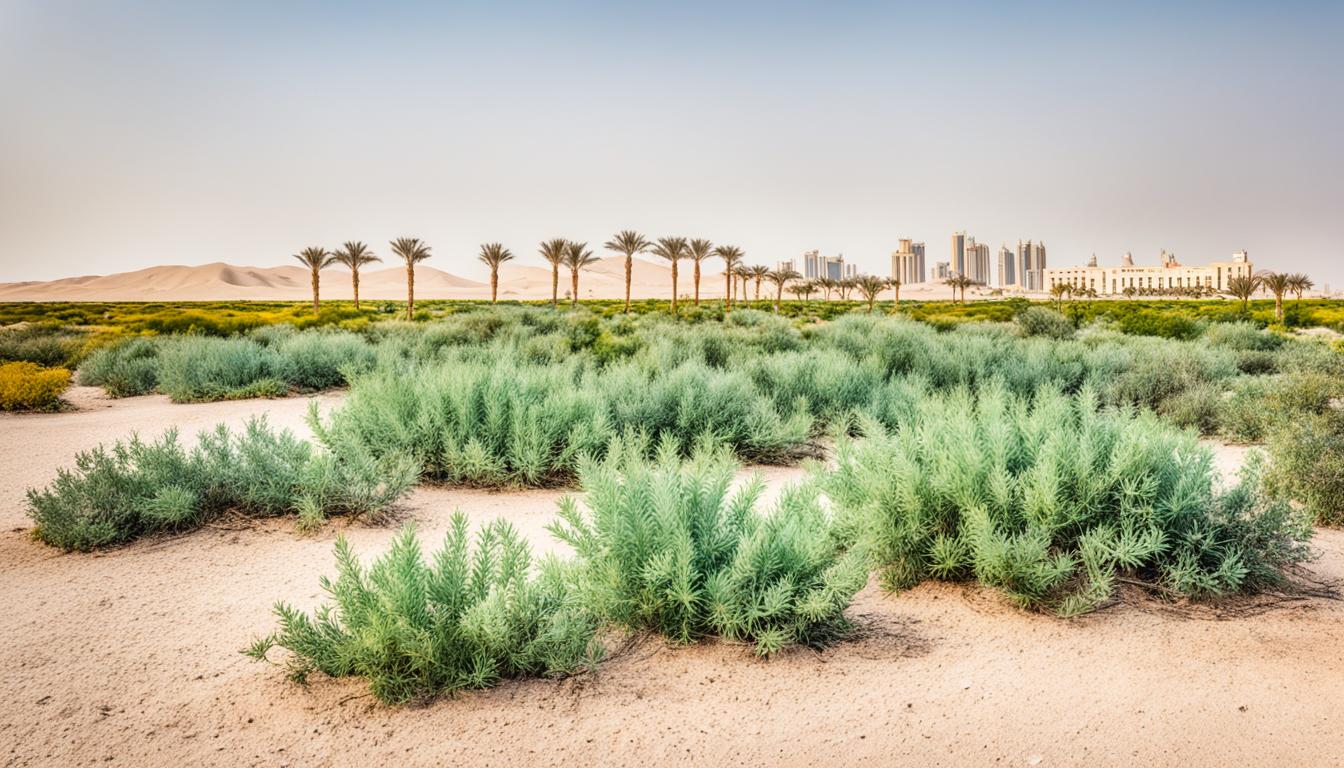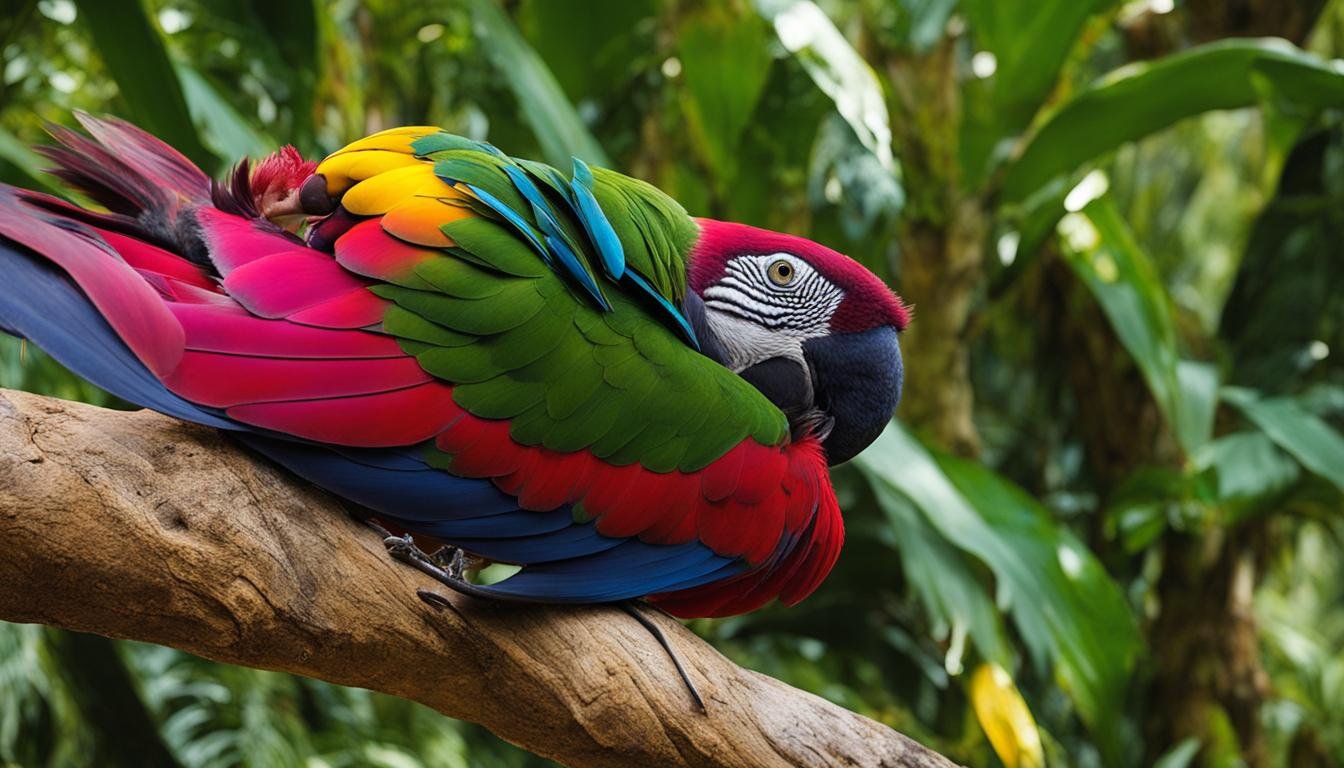Kiribati Sacred Natural Sites and Biodiversity
Did you know that the Phoenix Islands Protected Area (PIPA) in Kiribati spans an impressive 408,250 sq.km? That’s larger than many countries!
In this article, we will explore the rich biodiversity and cultural heritage of Kiribati, an island nation in the Southern Pacific Ocean. We’ll delve into the environmental protection measures, traditional land management practices, eco-friendly initiatives, and the country’s role in global conservation efforts. Join us on this journey to discover how Kiribati is striving to preserve its sacred natural sites and diverse ecosystem.
Key Takeaways
- Kiribati’s Phoenix Islands Protected Area (PIPA) is one of the world’s largest designated Marine Protected Areas, covering an expansive 408,250 sq.km.
- The conservation of biodiversity in PIPA is crucial for the overall health of the marine ecosystem and the protection of endangered species.
- Traditional land management practices in Kiribati, such as sustainable fishing and the establishment of sacred natural sites, have contributed to the preservation of biodiversity and cultural heritage.
- Kiribati has implemented eco-friendly initiatives to promote sustainable development and environmental protection, including the use of renewable energy sources and waste management programs.
- The country actively participates in global conservation efforts and collaborates with international partners to protect its unique biodiversity.
The Importance of PIPA for Biodiversity Conservation
The Phoenix Islands Protected Area (PIPA) is the largest designated Marine Protected Area in the world. It is home to one of the last intact oceanic coral archipelago ecosystems, making it a vital area for biodiversity conservation. PIPA spans over 408,250 sq.km and provides habitat for approximately 800 known species of fauna, including coral, fish, marine mammals, and birds.
The conservation of biodiversity in PIPA is crucial for the overall health and resilience of the marine ecosystem. It plays a significant role in the protection of endangered species and the preservation of coral archipelago ecosystems. By safeguarding PIPA, we ensure the survival of diverse marine life and maintain the balance of delicate ecosystems.
“PIPA is a global example of the importance of marine protected areas in safeguarding biodiversity and preserving natural heritage,” says Dr. Margaret Leinen, Director of Stanford University’s Center for Ocean Solutions.
Beyond its local significance, PIPA contributes to global efforts in biodiversity conservation. As a vast marine protected area, it serves as a model for sustainable marine management and provides valuable insights for future conservation initiatives worldwide.
To emphasize the need for PIPA’s protection, here is a comparison highlighting its vastness:
| PIPA | Comparable Land Area |
|---|---|
| 408,250 sq.km | The size of Belgium or slightly smaller than California |
Preserving a Unique Coral Archipelago Ecosystem
The coral archipelago ecosystems within PIPA are extraordinary and provide critical habitats for a diverse array of marine species. These ecosystems function as nurseries and breeding grounds, supporting the life cycles of numerous fish and other marine organisms. By safeguarding PIPA, we ensure the conservation of these crucial ecosystems and the services they provide to both marine life and people.
Traditional Land Management Practices in Kiribati
Kiribati has a long history of traditional land management practices that have played a crucial role in the preservation of biodiversity and cultural heritage. These practices are deeply rooted in the indigenous conservation practices of the Kiribati people, who have lived in harmony with their environment for generations.
One of the key traditional land management practices in Kiribati is sustainable fishing. The local communities rely on their expert knowledge of the marine ecosystem to ensure that fishing is carried out in a way that allows for the replenishment of fish stocks and the long-term sustainability of the resources. Traditional methods such as fish aggregating device (FAD) fishing and reef net fishing are still practiced to this day.
Another important practice is rotational farming. Due to limited land availability, the communities in Kiribati practice shifting cultivation, where they rotate their agricultural activities across different plots of land. This allows the soil to regenerate naturally and reduces the pressure on the land, ensuring its long-term fertility and productivity.
The establishment of sacred natural sites is a significant aspect of traditional land management in Kiribati. These sites are considered sacred and are protected by customary laws and cultural practices. They serve as important biodiversity hotspots and act as crucial habitats for a variety of flora and fauna. The local communities play a vital role in the management and conservation of these sites, ensuring their protection and preservation for future generations.
The combination of sustainable fishing, rotational farming, and the establishment of sacred natural sites reflects the deep connection between Kiribati’s cultural heritage preservation and biodiversity conservation. These practices embody the indigenous wisdom and knowledge that has been passed down through generations and continue to contribute to the sustainable management and protection of the unique natural environment in Kiribati.
Traditional Land Management Practices in Kiribati – Summary
| Traditional Practices | Description |
|---|---|
| Sustainable fishing | Fishing methods that ensure long-term sustainability and replenishment of fish stocks, such as fish aggregating device (FAD) fishing and reef net fishing. |
| Rotational farming | Shifting cultivation practices that rotate agricultural activities across different plots of land to allow for soil regeneration and long-term land fertility. |
| Sacred natural sites | Establishment of sites protected by customary laws and cultural practices, serving as important biodiversity hotspots and crucial habitats for flora and fauna. |
These traditional land management practices in Kiribati exemplify the country’s commitment to indigenous conservation practices and highlight the importance of community involvement in preserving the natural environment.
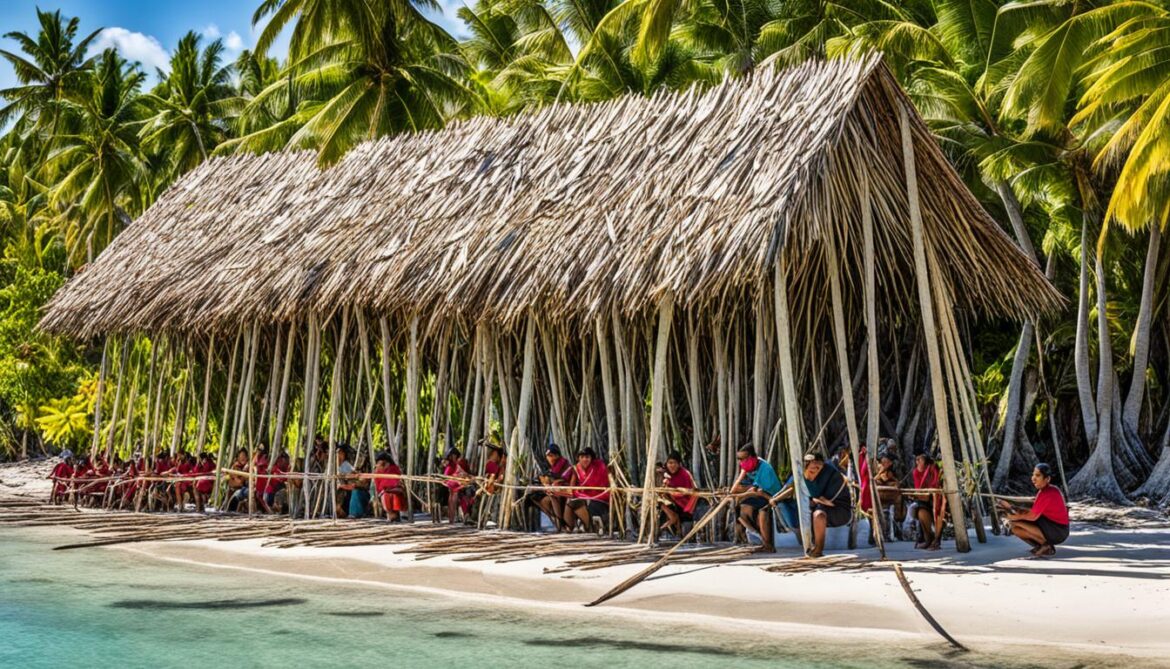
Eco-Friendly Initiatives in Kiribati
Kiribati is committed to promoting sustainable development and environmental protection through various eco-friendly initiatives. These initiatives aim to reduce the carbon footprint and preserve the unique biodiversity of the country. The government, in collaboration with local communities, has implemented several measures that focus on renewable energy, waste management, and the use of eco-friendly building materials.
Promotion of Renewable Energy Sources
Kiribati recognizes the importance of transitioning to renewable energy sources to achieve sustainable development. The government promotes the use of solar power, wind energy, and hydroelectricity to reduce reliance on fossil fuels. These initiatives not only help to mitigate greenhouse gas emissions but also provide clean and affordable energy for the local communities.
Waste Management Programs
To address the issue of waste pollution, Kiribati has implemented comprehensive waste management programs. These programs focus on recycling, proper waste disposal, and raising awareness about the importance of reducing waste generation. By promoting responsible waste management practices, Kiribati aims to protect its pristine natural environment and maintain its biodiversity.
Use of Eco-Friendly Building Materials
In line with sustainability goals, Kiribati encourages the use of eco-friendly building materials in construction projects. These materials have a lower environmental impact compared to conventional construction materials. By promoting the use of sustainable alternatives such as bamboo, recycled materials, and low-emission products, Kiribati strives to minimize resource depletion and preserve its natural ecosystems.
“Kiribati’s eco-friendly initiatives reflect its commitment to environmental protection and sustainable development.” – [Name]
Kiribati’s eco-friendly initiatives align with its overall goal of ensuring a harmonious coexistence between human activities and the natural environment. Through the promotion of renewable energy sources, waste management programs, and the use of eco-friendly building materials, Kiribati strives to create a greener and more sustainable future.
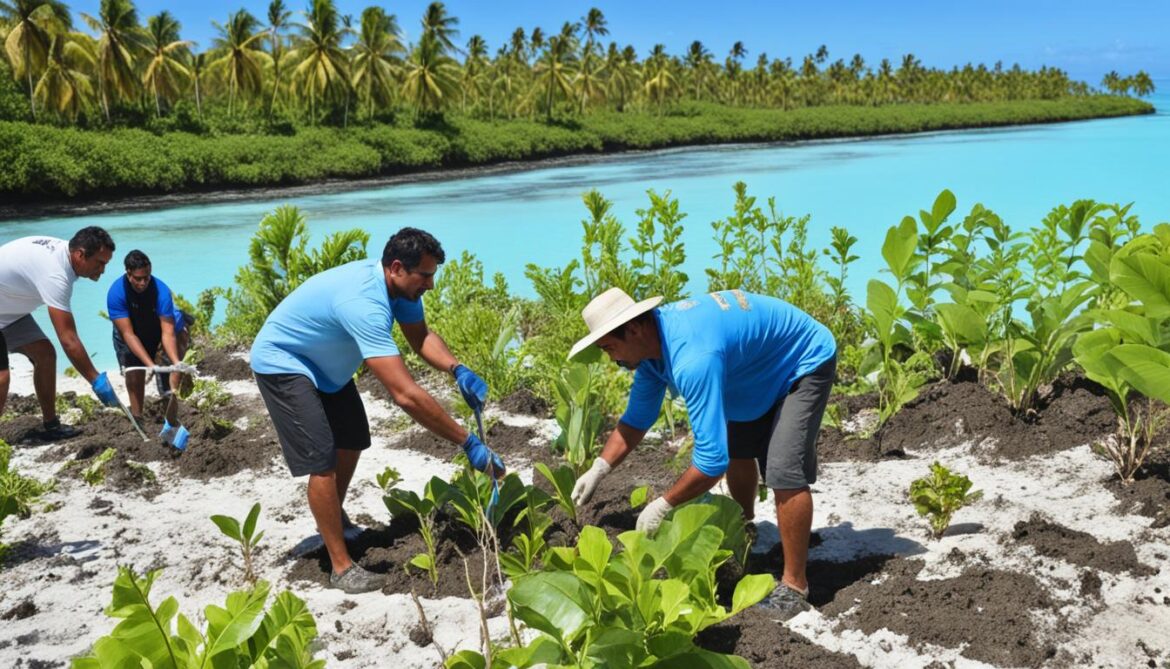
Kiribati’s Role in Global Conservation Efforts
Kiribati, with its commitment to protect and conserve its unique biodiversity, plays a significant role in global conservation efforts. One of the most notable examples of Kiribati’s dedication to biodiversity conservation is the establishment of the Phoenix Islands Protected Area. Spanning over 408,250 sq.km, it is the largest marine protected area in the world, safeguarding a diverse range of ecosystems and species.
Through the creation of this protected area, Kiribati demonstrates its proactive approach towards global conservation efforts. By preserving the Phoenix Islands’ delicate marine environment, the country contributes to the overall health and sustainability of our planet’s natural resources.
Kiribati also actively participates in international agreements and collaborations focused on promoting sustainable development and biodiversity conservation. The country recognizes that conserving its own natural heritage is intricately linked to the protection of the world’s biodiversity.
“Protecting biodiversity is not only about safeguarding Kiribati’s natural resources; it is a global responsibility that requires collective efforts. Kiribati, as a committed conservation partner, actively engages with stakeholders worldwide to preserve our shared natural heritage,” says President Taneti Maamau.
By collaborating with international partners and participating in global conservation initiatives, Kiribati amplifies its impact and advocates for the protection of biodiversity on a larger scale. The country’s dedicated efforts extend beyond its borders, inspiring other nations to prioritize conservation and work towards a sustainable future.
Through its holistic approach to biodiversity conservation, Kiribati serves as a model for other countries, demonstrating the importance of collective action in addressing global environmental challenges. By prioritizing the protection and conservation of its sacred natural sites and biodiversity, Kiribati reaffirms its commitment to safeguarding our planet’s ecological integrity for generations to come.
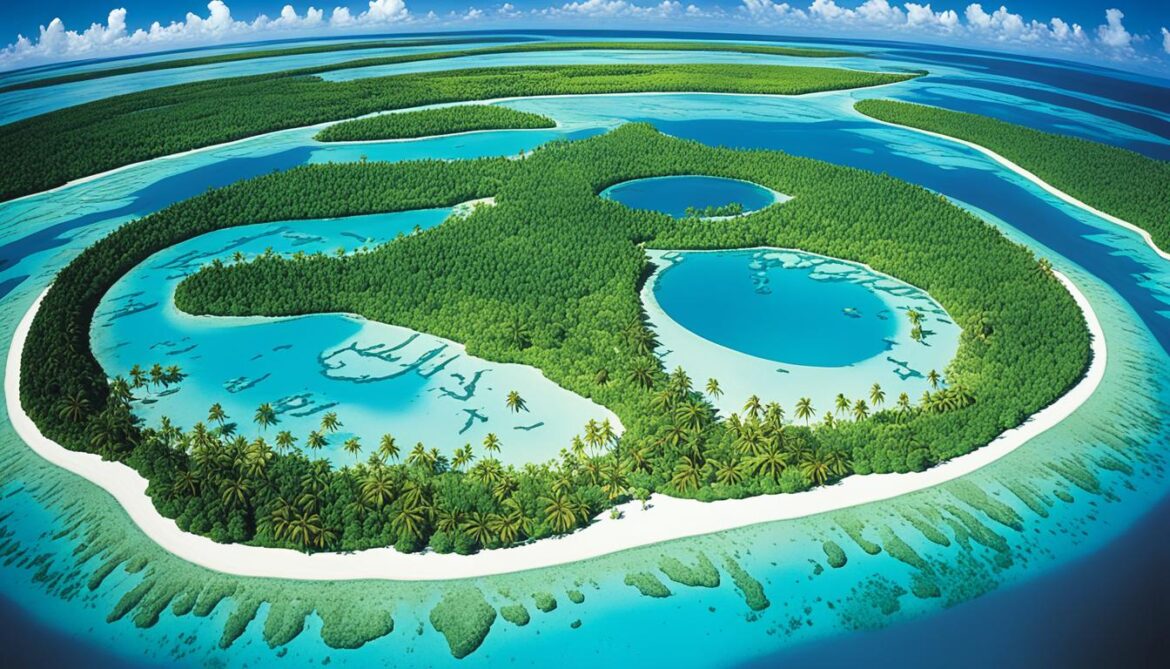
| Kiribati’s Contributions to Global Conservation Efforts | Impact |
|---|---|
| Establishment of the Phoenix Islands Protected Area | Preservation of one of the world’s largest marine protected areas, fostering biodiversity conservation on a global scale |
| Active participation in international agreements | Advocacy for sustainable development and biodiversity conservation, promoting a collaborative and comprehensive approach to global conservation |
| Inspiration for other nations | Setting an example for countries worldwide, encouraging the prioritization of biodiversity protection and sustainable practices |
Challenges and Threats to Biodiversity in Kiribati
Despite efforts to preserve biodiversity, Kiribati faces several challenges and threats to its unique natural heritage. These include climate change, habitat loss, invasive species, over-exploitation of resources, and limited financial and technical capacity. The government and local communities are working together to address these challenges and develop strategies for sustainable biodiversity conservation.
The impacts of climate change pose a significant threat to Kiribati’s biodiversity. Rising sea levels, increased temperatures, and changing weather patterns can negatively affect marine and terrestrial ecosystems. Coral reefs, crucial habitats for a wide range of species, are especially vulnerable to rising sea temperatures and ocean acidification, leading to coral bleaching and loss of biodiversity.
Habitat loss is another pressing issue. The increasing human population and development activities result in the destruction of natural habitats, such as mangroves and forests, which are essential for various plant and animal species. Land reclamation and urbanization further contribute to the loss and fragmentation of habitats, disrupting ecological balance and species interactions.
Invasive species also pose a significant threat to Kiribati’s biodiversity. Non-native species, introduced intentionally or unintentionally, can outcompete native species, predate upon them, or disrupt their natural habitats. This can lead to the decline or even extinction of indigenous plant and animal species, upsetting the delicate ecological balance.
Over-exploitation of resources is a major concern in Kiribati. Unsustainable fishing practices, such as overfishing and destructive fishing methods, can deplete fish populations and damage marine ecosystems. Illegal, unreported, and unregulated fishing exacerbates the problem, making it challenging to manage and conserve marine resources effectively.
Despite the government’s commitment to biodiversity conservation, limited financial and technical capacity pose challenges. Kiribati faces resource constraints, making it difficult to implement comprehensive conservation measures, conduct scientific research, and build the necessary infrastructure. International collaborations and support are crucial in overcoming these challenges and strengthening biodiversity conservation efforts in Kiribati.
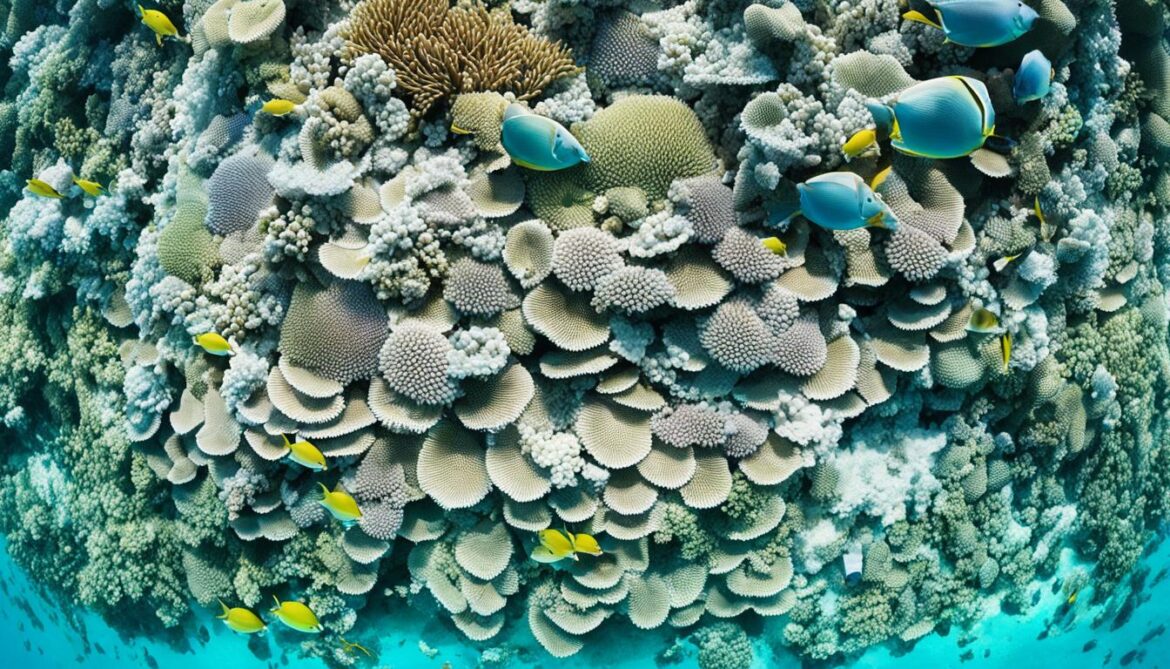
Community Involvement in Biodiversity Conservation
Community involvement plays a pivotal role in ensuring the successful conservation of biodiversity in Kiribati. The local communities are actively engaged in managing and safeguarding their natural resources through the implementation of traditional practices and the establishment of community-based conservation areas. Their profound connection to the land and sea, along with their rich knowledge and treasured traditions, greatly contribute to the sustainable management of biodiversity.
By actively participating in the conservation efforts, the local communities demonstrate their commitment to preserving the Kiribati Sacred Natural Sites and Biodiversity. Through the inherited wisdom passed down through generations, they have developed indigenous conservation practices that harmoniously coexist with nature. These practices include sustainable fishing techniques, rotational farming methods, and the creation of sanctified sites that are revered and protected by the community.
“The involvement of local communities is vital in preserving the biodiversity of Kiribati. Our deep knowledge and understanding of our environment, combined with our cultural beliefs, empower us to take responsibility for the conservation of our natural heritage.” – Tekaai Tekaiara, Community Leader.
Community-based conservation areas are designated territories managed by the local communities themselves. These areas serve as hubs for biodiversity protection, allowing the community members to actively participate in monitoring and managing the ecosystem. By involving the community in decision-making processes and resource management, these areas create a sense of ownership and responsibility among the locals, ensuring the long-term sustainability of biodiversity conservation in Kiribati.

Through their meaningful contributions, the local communities in Kiribati catalyze positive change and foster a deep sense of environmental stewardship. The integration of traditional knowledge, customs, and practices with modern conservation approaches creates a unique and holistic approach to biodiversity conservation.
Benefits of Community Involvement in Biodiversity Conservation:
- Enhanced understanding and appreciation of local ecosystems
- Increased community awareness and education about biodiversity conservation
- Preservation of cultural heritage and traditions
- Economic opportunities through sustainable tourism and ecotourism
- Strengthened social cohesion and community empowerment
In summary, the active participation of local communities is fundamental to the successful preservation of Kiribati’s sacred natural sites and biodiversity. Their deep connection to the land, rich cultural heritage, and indigenous conservation practices provide a foundation for sustainable management and conservation efforts. By empowering and engaging the community in biodiversity conservation, Kiribati ensures the long-term protection of its unique natural heritage for future generations.
Future Plans for Biodiversity Conservation in Kiribati
Kiribati is committed to the long-term protection and conservation of its unique biodiversity. To guide future efforts, the country has developed a comprehensive National Biodiversity Strategy and Action Plan (NBSAP). The NBSAP focuses on strengthening conservation measures, promoting sustainable development, and enhancing community participation.
Through the NBSAP, Kiribati aims to implement innovative strategies that effectively safeguard the Kiribati Sacred Natural Sites and Biodiversity. This includes the establishment of new protected areas, the development of sustainable land management practices, and the conservation of critical habitats.
Furthermore, the government of Kiribati recognizes the importance of international collaboration in biodiversity conservation. It actively seeks partnerships with international organizations and funding opportunities to support the implementation of the NBSAP and ensure the long-term success of biodiversity conservation efforts.
The Goals of the NBSAP
The National Biodiversity Strategy and Action Plan for Kiribati strives to achieve the following objectives:
- Enhance the protection and conservation of Kiribati’s unique biodiversity
- Minimize the impact of human activities on the environment
- Promote sustainable development practices that harmonize economic growth and biodiversity conservation
- Engage local communities in the conservation and management of natural resources
- Strengthen national capacity in biodiversity research, monitoring, and management
- Ensure the integration of traditional knowledge and practices into biodiversity conservation strategies
The NBSAP provides a comprehensive framework for achieving these goals and serves as a roadmap for the future of biodiversity conservation in Kiribati.
Opportunities and Challenges
Implementing the NBSAP presents both opportunities and challenges for Kiribati. By prioritizing biodiversity conservation, Kiribati can enhance ecosystem resilience, promote sustainable tourism, and support the livelihoods of local communities. The engagement of local communities in conservation efforts also strengthens traditional land management practices and cultural heritage preservation.
However, challenges such as limited financial and technical resources, climate change, and the need for capacity-building remain. Kiribati is actively seeking collaborations with international partners to address these challenges and secure the necessary resources for successful biodiversity conservation.
| Opportunities | Challenges |
|---|---|
| Promotion of sustainable tourism | Limited financial resources |
| Ecosystem resilience enhancement | Climate change impacts |
| Support for local livelihoods | Technical capacity-building |
| Strengthening traditional land management practices | Resource constraints |
In conclusion, Kiribati’s National Biodiversity Strategy and Action Plan represents a significant step towards the protection and conservation of the country’s unique biodiversity. By implementing innovative strategies, engaging local communities, and seeking international collaborations, Kiribati is actively working towards a sustainable future where biodiversity and cultural heritage thrive.

Conclusion
Kiribati’s sacred natural sites and biodiversity are integral to the country’s environmental protection, cultural heritage preservation, and sustainable development. Through initiatives such as the Phoenix Islands Protected Area and the implementation of the National Biodiversity Strategy and Action Plan, Kiribati has made great progress in conserving its diverse ecosystems. However, challenges and threats remain, necessitating ongoing efforts to safeguard Kiribati’s natural heritage for future generations.
In collaboration with the government, local communities, and international partners, Kiribati is committed to the protection and preservation of its sacred natural sites and biodiversity. By working together, we can address challenges such as climate change, habitat loss, and invasive species, while promoting sustainable land management and cultural traditions.
It is crucial that we continue to support biodiversity conservation efforts in Kiribati. By investing in environmental protection, sustainable development, and traditional land management practices, we can ensure the long-term existence of Kiribati’s unique natural resources. Let us unite in our commitment to preserving Kiribati’s sacred natural sites and biodiversity, for they are not only vital to the country’s identity but also to the well-being of our planet as a whole.





